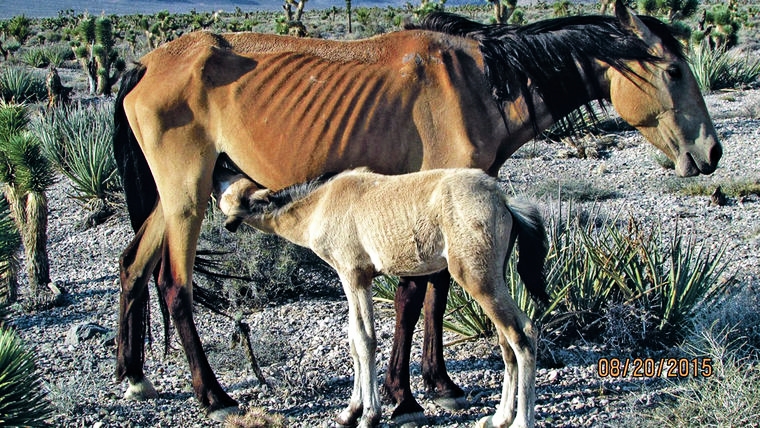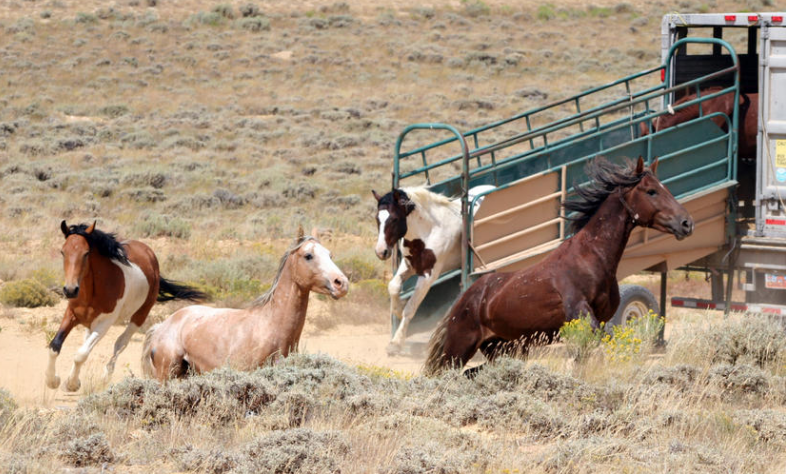Good management of wild horses means treating them as what they are, livestock. Bison, once found in the millions on the wild prairies of North America, and driven to near-extinction in an effort to make room for western settlements, were saved and are being robustly restored by human management–also known as ranching.
by Marjorie Haun
Although certain animal rights groups and environmental extremists have hysterically decried the Trump Administration’s new Wild Horse and Burro management plan, those who actually deal with wild horse and burro populations, and must make the hard decisions that come with animal management, support the plan.
Various left-wing news sites, and extreme groups seeking donations via dramatic propaganda about the new plan, have claimed the Administration is ‘selling out wild horses’ (Huffpo), and ‘wild horses could be sold for slaughter under Trump budget plan,’ (PBS Newshour). Without scientific understanding of the wild horse problem, it’s easy to fall for the hysterics. But the National Horse & Burro Rangeland Management Coalition, a group of livestock, wildlife and land conservation experts who apply actual horse sense to creating ‘ecologically-sound approaches to managing horses and burros to promote healthy wildlife and rangelands for future generations,’ has a very different take on the Bureau of Land Management’s (BLM) revised plan. In a recent press release they stated:
Statement on BLM’s Wild Horse & Burro Management Program FY2018 Budget Request
President Trump’s Fiscal Year 2018 Budget Proposal calls for the removal of appropriations language that restricts the BLM from using all management options authorized under the Wild Free Roaming Horse and Burro Act of 1971, as amended. The President’s request implements a September 2016 recommendation of the National Wild Horse & Burro Advisory Board, an independent federal advisory committee representing broad stakeholder interests.
The National Horse & Burro Rangeland Management Coalition supports the Administration’s appropriations request to provide necessary flexibility for BLM to manage wild horses and burros. The Coalition supported the Advisory Board’s recommendation and called for the removal of the appropriations language in its 2017 Transition Document. The Coalition acknowledges the removal of the management restrictions as a critical step to ensure wild horses and burros can continue to thrive alongside our native wildlife on healthy public rangelands.
BLM is currently burdened with caring for more than 45,000 un-adopted wild horses and burros in holding facilities, costing taxpayers nearly $50 million per year. On-range populations of wild horses and burros continue to increase, with the March 2017 report indicating a population of 73,000 individuals—well above the ecologically-based population objective of less than 27,000. The already limited number of on-range gathers conducted by BLM should not be reduced to lower the cost of the program.
Adoption demand is not high enough to match the on-range population growth rates. Limited fertility control efforts are not effective in reducing populations. The financial burden of housing thousands of horses and burros has restricted the agency’s ability to manage horse and burro populations on the rangelands—and as a result, the health of those rangelands continues to decline, with negative implications for native wildlife, the health of the horses and burros, and other multiple-uses of our country’s rangelands.
Removal of the restricting appropriations language, combined with increased gather and removal efforts, will help ensure healthy rangelands for future generations to come. Healthy rangelands allow native wildlife to thrive, livestock to graze to support local communities, wild horses and burros to live healthy lives, and water quantity and quality to be sustained. Healthy rangelands are essential to the Western way of life. Removal of the appropriations language removes roadblocks to the effective management of on-range populations of wild horses and burros.
The key complaint–and donation-generator–coming from the ‘animal rights’ Left has been that the new appropriations language allows the BLM to euthanize, or sell excess horses to commercial slaughter houses. What these left-wing groups fail to tell their donors is that unfettered wild horse populations are unsustainable. And in the West, where range forage and water are sparse, the animals will compete with wildlife populations, leading to mortality in deer, elk, bighorn sheep and other species, and will degrade rangeland to the point that all species, including horses, burros, cattle, large wildlife, and small mammals and birds, will succumb to deprivation, disease and starvation.
Language from the BLM proposal addresses ‘unsustainable constraints’ in prior management programs which effectively prevented the agency from creating healthy herds of a manageable size. Trump’s budget will free the agency to refocus on the mission of the Wild Free-Roaming Horse and Burro Act, and return ‘the WHB program back to traditional management strategies,’ as opposed to the emotionally-stoked, politically-driven policies that have hampered effective wild horse management for several years. It says, in part:
“The budget reflects a $10.0 million program reduction to the Wild Horse and Burro Management program. The consistent growth in annual costs for the program is unsustainable and constrains the Bureau’s ability to effectively address competing uses of public lands, as the number of animals on the range and in BLM holding facilities grows. Over the past eight years, the program’s budget has more than doubled, rising from $36.2 million in 2008 to $80.4 million in 2017.
Despite these increases, the program remains far from achieving a key statutory obligation under the Wild Free-Roaming Horse and Burro Act of 1971: maintaining animal populations on the range at appropriate management levels. The WHB program has been principally consumed by the cost to care for excess animals in off-range facilities. The current program is unsustainable and a new approach is needed, particularly when overall Federal funding is so constrained. As such, the budget proposes to give BLM the tools it needs to manage this program in a more cost-effective manner, including the ability to conduct sales without limitation.
The budget proposes to eliminate appropriations language restricting BLM from using all of the management options authorized in the Wild Free-Roaming Horse and Burro Act. The remainder of the funding decrease will be achieved by reducing gathers, reducing birth control treatments, and other activities deemed inconsistent with prudent management of the program. The long-term goal is to realign program costs and animal populations to more manageable levels, enabling BLM to reorient the WHB program back to these traditional management strategies.”


Good management of wild horses means treating them as what they are, livestock. Bison, once found in the millions on the wild prairies of North America, and driven to near-extinction in an effort to make room for western settlements, were saved and are being robustly restored by human management–also known as ranching. America’s wild horses and burros are indeed iconic, but being the feral descendants of domesticated livestock, cannot be regarded as truly wild. Although ‘animal rights’ groups and ‘wild horse advocates’ bring in a lot of cash using the mythology of the ‘majestic wild mustang being under threat by human management policies,’ the science behind these animals dictates very different, and ultimately more humane, solutions to a tragic problem.
Please contact your legislators, and ask them to support humane and effective management of Wild Horses and Burros, and thank President Trump, showing your support of the new BLM plan. You can also contact the White House, or tag Interior Secretary Ryan Zinke (@SecretaryZinke), the national office of the Bureau of Land Management (@BLMNational) or President Trump (@POTUS), in social media posts.


